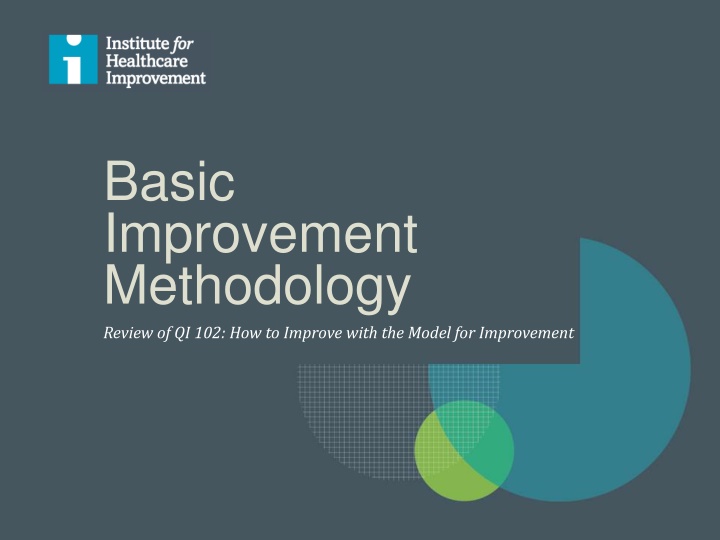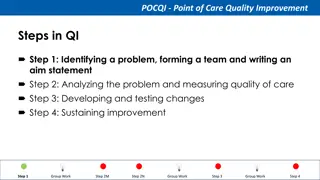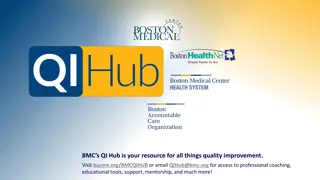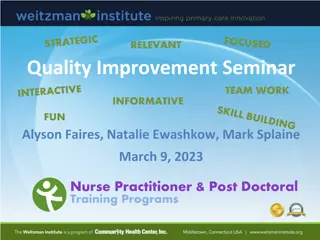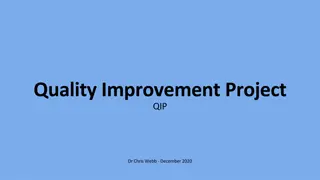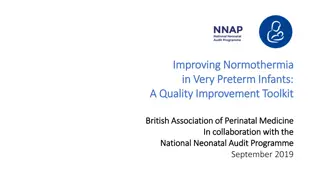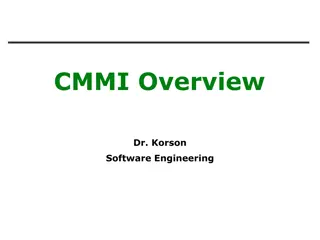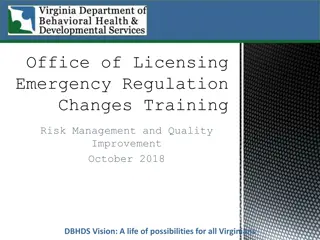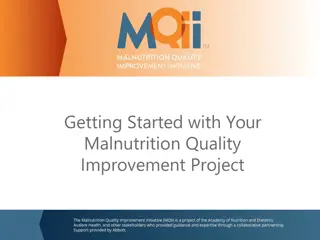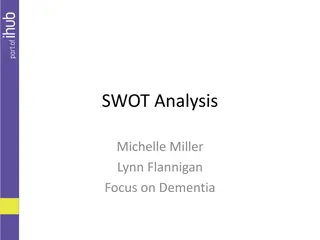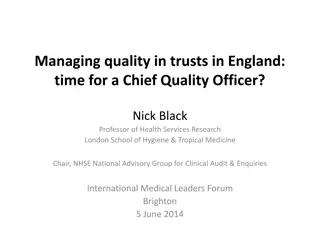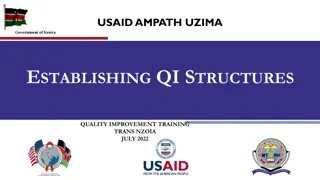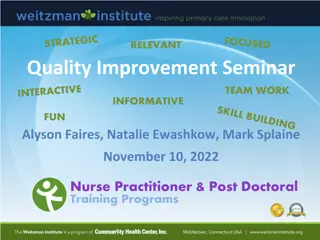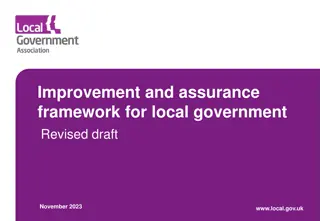Improving Quality with the Model for Improvement
In this content, we delve into the Model for Improvement methodology, focusing on key aspects such as setting aims, choosing measures, developing and testing changes. It discusses the three questions in the Model, elements of an effective aim statement, types of measures, and utilizing change concepts for improvement. Practical steps like testing changes on a small scale using the PDSA cycle are highlighted, emphasizing the importance of will, ideas, and execution in the improvement process. Various improvement methods like Lean and Six Sigma are touched upon, alongside examples of aim statements for clarity.
Download Presentation

Please find below an Image/Link to download the presentation.
The content on the website is provided AS IS for your information and personal use only. It may not be sold, licensed, or shared on other websites without obtaining consent from the author.If you encounter any issues during the download, it is possible that the publisher has removed the file from their server.
You are allowed to download the files provided on this website for personal or commercial use, subject to the condition that they are used lawfully. All files are the property of their respective owners.
The content on the website is provided AS IS for your information and personal use only. It may not be sold, licensed, or shared on other websites without obtaining consent from the author.
E N D
Presentation Transcript
Basic Improvement Methodology Review of QI 102: How to Improve with the Model for Improvement
Lecture Objectives 1. List the three questions in the Model for Improvement 2. Identify the key elements of an effective aim statement 3. Identify three kinds of measures: process, outcome, and balancing measures 4. Use change concepts and critical thinking tools to come up with good ideas for changes to test 5. Test changes on a small scale using the Plan- Do-Study-Act (PDSA) cycle
Lecture Outline An Overview of the Model for Improvement Setting an Aim Choosing Measures Developing Changes Testing Changes
How Can We Improve? 1. Will. You must have the will to improve 3. Execution. You must make it real. 2. Ideas. You must have ideas about alternatives to the status quo.
How Can We Improve? 1. Will. You must have the will to improve 3. Execution. You must make it real. 2. Ideas. You must have ideas about alternatives to the status quo.
Improvement Methods Model for Improvement Lean Six Sigma Having a standard road map for improvement rather than the specific framework you decide to use is what s most important
Step 1: Set an Aim How good? For whom? By when?
Step 1: Set an Aim How good? For whom? By when? Bold Realistic Clear Concise Measureable Meaningful
Which is the better aim statement? Reduce all types of hospital-acquired infections by as much as possible, as quickly as possible. Decrease the rate of hospital-acquired pneumonia for patients in the ICU from 23 infections per 1,000 catheter days to less than 5 infections per 1,000 catheter days by May 1.
Which is the better aim statement? Reduce all types of hospital-acquired infections by as much as possible, as quickly as possible. Decrease the rate of hospital-acquired pneumonia for patients in the ICU from 23 infections per 1,000 catheter days to less than 5 infections per 1,000 catheter days by May 1.
Step 2: Establish Measures Outcome measures Process measures Balancing measures
Step 2: Establish Measures Outcome measures Process measures Balancing measures Where are we going? What are we doing? What else is happening?
Which measure is which? Average number of times patients receive recommended oral care in 24 hours Patient and staff satisfaction scores Rate of hospital-acquired pneumonia per 1,000 catheter days in the ICU
Which measure is which? Average number of times patients receive recommended oral care in 24 hours process Patient and staff satisfaction scores balancing Rate of hospital-acquired pneumonia per 1,000 catheter days in the ICU outcome
Step 3: Developing Changes Process analysis tools Benchmarking Technological solutions Creative thinking Change concepts
Change Concepts 1. Eliminate waste 2. Improve workflow 3. Optimize inventory 4. Enhance the producer-customer relationship 5. Change the work environment 6. Manage time 7. Manage variation 8. Design systems to prevent errors 9. Focus on the design of products and services
What changes could improve oral care in the ICU? Improve workflow Optimize inventory Change the work environment Manage variation Design systems to prevent errors Other ideas?
What changes could improve oral care in the ICU? Improve workflow Ensure mouth-cleaning supplies are kept in ready-to-go state Optimize inventory Ensure toothbrushes, mouthwash, etc. are consistently available Change the work environment Train hospital staff on proper mouth-cleaning technique and importance Manage variation Update oral care policy to be consistent with CDC guidelines for all patients Design systems to prevent errors Post the oral-care protocol in visible places
Step 4: Testing Changes Plan Questions & predictions Who/what/where/when? Do Observe the test Document results Study Draw run charts Analyze the data Act Refine the change and plan for the next cycle
Linking PDSA Test Cycles Start small Think ahead Don t wait to begin!
Video https://youtu.be/8Q7qnNpTWxM http://www.ihi.org/education/IHIOpenSchool/resources/Pages/Activities/PDSACyclesFromCLABSIsToCucumbers.aspx
Discussion In the example about CLABSIs, what would be a reasonable next PDSA cycle? What PDSA cycles do you use in your daily work, even if that s not the name you use for them? What s the value of a failed PDSA cycle? Think about the last PDSA cycle you ran in your personal life even if you didn't know it was a PDSA cycle at the time. Was it successful? Why or why not? http://www.ihi.org/education/IHIOpenSchool/resources/Documents/Facilitator_PDSACyclesFromCLABSIsToCucumbers.pdf
Exercise Go to http://www.ihi.org/education/IHIOpenSchool/Cou rses/Documents/QI102_exercise.pdf and practice planning an improvement project. Ask a partner to review your work, using the reviewer questions as a helpful guide. Refine your worksheet based on peer feedback.
Discussion How did you select your aim, measures, and changes? What is your level of confidence you will be able to make this change? How do you think having this written plan will help you? What did you learn during this activity? http://www.ihi.org/education/IHIOpenSchool/Courses/Documents/QI102_exercise.pdf
